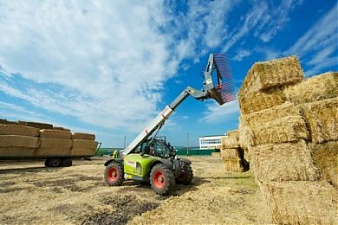Agriculture, Education and Science, Energy, EU – Baltic States, Good for Business, Latvia, Markets and Companies, Technology
International Internet Magazine. Baltic States news & analytics
Friday, 05.12.2025, 08:38
Latvian scientists make bioethanol and furfural from straw
 Print version
Print version |
|---|
Expert opinions are gloomy. We are slowly running out of everything, including oil that might last only for another 40 years or even less. Humanity has already used up 70% of all natural hydrocarbon sources. At the same time, intensity of hydrocarbon consumption keeps accelerating at a rate that is too fast. The time is right for scientists to think about what happens next. Search for an alternative to oil which at present is used both to make fuel and as a raw material in production of a vast array of products in chemical industry has become one of the key practical objectives.
Bioethanol – alternative to oil
Production of bioethanol is one of the main modern technologies as bioethanol represents an alternative energy source of utmost importance in replacing ordinary fuel. Every year developed world countries pour huge financial resources into development and improvement of bioethanol, and alcohol output is rising at an enormous rate.
This is evidenced by the data on the global production and consumption of ethanol as a full or partial replacement for fuel published by the US Energy Information Administration in its Monthly Energy Review June 2015. Thus, alcohol output increased from 38.627 thousand barrels in 2000 to 92.961 thousand barrels in 2005, to 260.424 thousand barrels in 2009 and to 341.419 thousand barrels in 2014.
Latvian scientists develop new technology
Naturally, the most appealing are those technologies for production of alcohol that use renewable plant resources as the main raw material. If the plants have no food use, even better. This was the subject of the research by a group of Latvian scientists headed by Prof. Alexander Rapoport (Aleksandrs Rapoports) from the University of Latvia Institute of Microbiology and Biotechnology, Corresponding Member of the Latvian Academy of Sciences, and Prof. Nikolay Vedernikov (Nikolajs Vederņikovs) from the Latvian State Institute of Wood Chemistry, Academician of the Latvian Academy of Sciences. Their objective was to develop technologies utilizing basic local resources – waste generated by agricultural and wood-processing industries. As part of a project financed from the European Regional Development Fund (project 2014/0026/2DP/2.1.1.1.0/14/APIA/VIAA/002) carried out over the past year they succeeded in showing the possibilities for making bioethanol from wheat straw which the agricultural sector discards in vast amounts every year.
It is very important that the technology uses not just a local Latvian resource but a resource available in practically all developed European countries which could also benefit from this unique method, if they so wished. The project of the Latvian scientists is titled ”Biotechnological basis for the simultaneous production of bioethanol and furfural from wheat straw”. Co-generation of the two products – ethanol and furfural – is what makes their method unique.
What’s furfural?
Everybody knows what ethanol is. But what’s furfural?
Ethanol and furfural are two main components that can be used for a variety of syntheses in chemical industry. About 95% of all synthetic materials produced in modern times can be created using these two chemical compounds that can be obtained from renewable plant biomass.
Considering that in the nearest future ethanol apparently is going to be used mostly as an alternative energy source to oil, furfural becomes one of the main substitutes for oil as a resource in the chemical industry. Today large amounts of furfural are already being generated across the world from renewable plant material – the same material that can be used to produce ethanol. What’s most interesting is that both those products can be obtained from different parts of the same plant material – furfural from five-carbon units and ethanol from six-carbon units.
It would seem that everything is just fine – let’s make both products simultaneously. But there is a catch – it turned out that 40-50% of cellulose get irreversibly damaged in the process of making furfural and therefore can no longer be used to produce alcohol. And five-carbon units still are no good when it comes to making ethanol, although theoretically it should be possible to generate furfural as a compound for organic synthesis and ethanol as a motor fuel all at once. As a result, both ethanol and furfural are often made from the same plant material but at different production facilities and by technologies that are completely different and unrelated to each other, and a significant portion of the raw material gets wasted beyond recovery in the process. This is how it was.
Unique method offers new opportunities
Today, due to the work of the Latvian scientists, a breakthrough is close. Thorough research conducted by Prof. Nikolay Vedernikov for many years has opened a chance to change the mechanism of furfural formation to exclude permanent damage to residual cellulose.
Microbiologists immediately made use of this discovery and proved that the substrate left after furfural formation can be effectively turned into glucose. To this end, it has to be treated with advanced commercial enzymes – cellulases – which were kindly supplied for this research by DuPont company. What comes next is very simple – the quite “traditional” microbiological process of using yeast to generate alcohol. Nevertheless, the Latvian scientists made some rather significant modifications also to this phase to increase the economic efficiency of this “traditional” process.
The Latvian scientists also came up with another innovation. Once you have obtained furfural and alcohol, you are left with one more component of plant material – lignin. A group of researchers headed by Ass. Prof. Natalya Matjuskova (Nataļja Matjuškova) established that lignin can be effectively used to grow shiitake mushrooms which have recently come into vogue and contain biologically active and healthy substances.
Ball in business’ court
 |
|---|
Тhus the Latvian scientists have developed biotechnological basis for wasteless downstream processing of cheap agricultural waste – wheat straw – into valuable, expensive and much-need products – furfural, ethanol and biologically active compounds.
The scientists have done their job. The ball is now in the court of business representatives. Who will be the first to seek to put into real life these accomplishments by the Latvian scientists?
But the researchers are not going to stop at this. If their new project proposals are approved, they will try to develop similar processes for other types of agricultural waste large amounts of which are left unused in the fields in Latvia and other European countries.








 «The Baltic Course» Is Sold and Stays in Business!
«The Baltic Course» Is Sold and Stays in Business!

